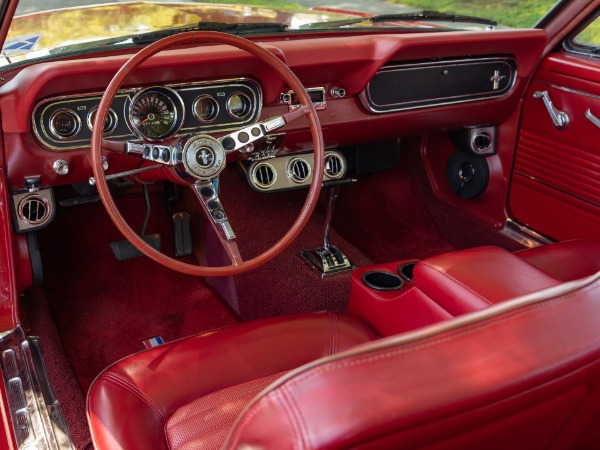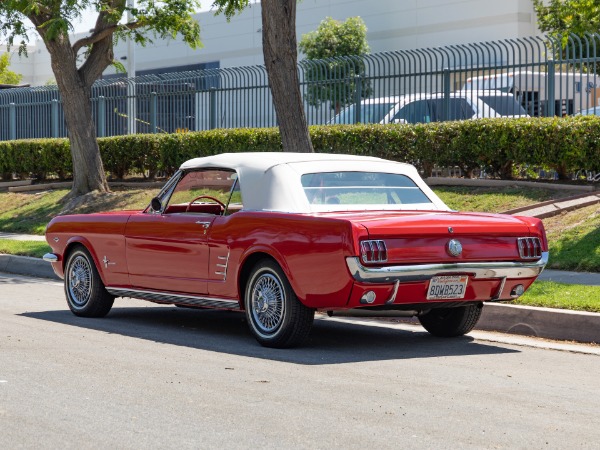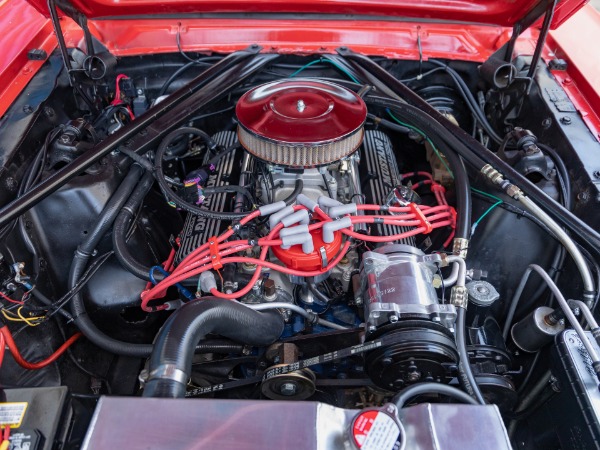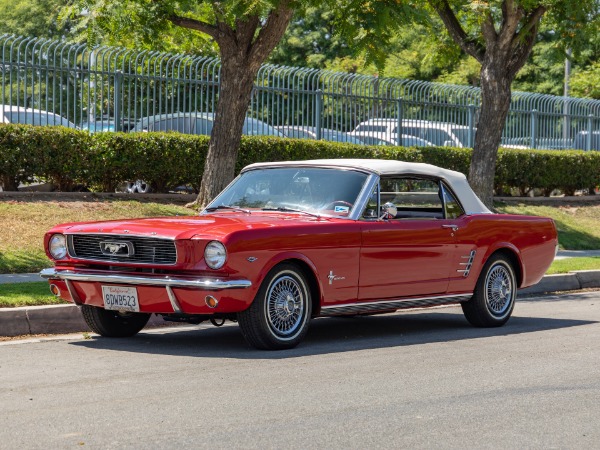Discover the 1966 Ford Mustang, an icon in American automotive history that embodies the spirit of freedom and power. This classic ‘pony car’ took the world by storm, offering an irresistible blend of style, performance, and affordability that continues to captivate car enthusiasts today.
Origins and Evolution:
The Ford Mustang story began in the early 1960s, with Ford executives recognizing a gap in the market for a compact, sporty car that could appeal to the baby boomer generation. Thus, the Ford Mustang was born, debuting at the New York World’s Fair on April 17, 1964, and going on sale the same day.
Designed under the guidance of Ford’s, Joe Oros, responsible for the overall design of the original Mustang. He is credited with the car’s signature long hood and short deck design. Oros, as a part of Ford’s design team, worked on the Mustang project under the code name T-5. The car was developed to appeal to the younger generation, and Oros and his team managed to create a design that was both sporty and elegant. Gale Halderman was a part of Oros’ design team and played a significant role in designing the Mustang. Halderman is credited with sketching the original design of the Mustang, a sketch that was chosen by Joe Oros from among several others. Halderman’s sketch, characterized by its simplicity and sharp lines, became the foundation of the final design of the Mustang. Lastly, while not a designer in the conventional sense, Lee Iacocca’s contribution to the Mustang cannot be overstated. As the vice president and general manager of Ford Division at the time, Iacocca championed the idea of a sporty, compact car aimed at the post-war baby boom generation. His vision and leadership were instrumental in the development and success of the Mustang.By 1966, just two years after its launch, the Mustang had already carved out its niche in automotive history. With over a million units sold, the car was nothing short of a cultural phenomenon. The 1966 model, while not drastically different from its predecessors, featured subtle refinements that further solidified its reputation.

1966 Ford Mustang: Specifications and Design:
The 1966 Ford Mustang maintained the model’s classic look, with its long hood, short rear deck, and muscular stance. However, Ford introduced minor cosmetic tweaks to give the Mustang a fresh appearance. This included a redesigned grille, new wheel covers, and a new gas cap. The iconic pony emblem, previously in the corral, was now placed directly on the grille, giving the Mustang an even more distinctive look.
Inside, the Mustang offered a range of options for customization, a feature that set it apart from competitors. Customers could choose from a variety of interior colors, multiple seat styles, and optional extras like air conditioning and the Rally-Pac gauge cluster.
Under the hood, the 1966 Mustang provided a choice of several engines. The base model came with a 200-cubic inch, inline-six engine producing 120 horsepower. There were also three V8 options, including the popular 289-cubic inch engine, which came in three versions: the 2-barrel carburetor version with 200 horsepower, a 4-barrel version with 225 horsepower, and the high-performance Hi-Po (“K-code”) version with 271 horsepower.
The car was available in three body styles: the Hardtop, the Convertible, and the Fastback. The Fastback, with its sloping rear roofline, was particularly popular, giving the Mustang a sportier profile.
Performance:
The 1966 Mustang offered several engine options that catered to a variety of performance demands. The base model was powered by a 200-cubic inch inline-six engine, which produced 120 horsepower. This engine provided ample power for day-to-day driving but for those who desired more performance, there were three V8 options. The most potent of these was the 289-cubic inch Hi-Po (High Performance) V8, known as the “K-code” engine. It came equipped with a 4-barrel carburetor and a solid-lifter camshaft, enabling it to churn out 271 horsepower and 312 lb-ft of torque. This engine propelled the Mustang from 0 to 60 mph in under 8 seconds, an impressive feat for the time.

Representation and history in Motorsports:
The Mustang’s performance and handling characteristics made it a popular choice in various forms of motorsports. The most notable of these was its involvement in the Trans-Am Series. The Mustang, under the Shelby American team, competed in the over 2-liter class of the series.
Carroll Shelby, a renowned automotive designer and racing driver, partnered with Ford to create high-performance versions of the Mustang. The result was the Shelby GT350, a car that was both street-legal and track-ready. The 1966 Shelby GT350 featured modifications including improved suspension, a ‘hi-riser’ intake manifold, and glasspack mufflers, among other things. In the hands of talented drivers like Jerry Titus, the Shelby GT350 demonstrated the Mustang’s racing pedigree by securing multiple victories in the Trans-Am Series.
In addition to circuit racing, the Mustang was also popular in drag racing. Ford offered a drag racing package known as the “Drag Pack” for the 1966 Mustang. This included a limited-slip differential, a larger radiator, and other modifications to make the car more competitive on the drag strip.
Click Here: Our 1966 Ford Mustang Custom Convertible
‘We are excited to showcase a beautifully restored 1966 Ford Mustang ‘C’ code 289 V8 Convertible, which pairs authentic vintage appeal with modern enhancements. This classic American muscle car, in its original ‘Candyapple Red’ paint, features a refurnished ‘Red Vinyl & Red Rosette’ interior, accentuated by a pristine ‘White’ power soft top.
Equipped with a fully rebuilt, fuel-injected 289 V8 engine, this Mustang provides an engaging driving experience through an effortless automatic transmission. For added comfort and safety, it also includes contemporary upgrades such as aftermarket air conditioning and power front disc brakes.
The Mustang, the pioneer of the ‘Pony car’ segment, remains an icon of the ’60s. Its legendary design, defined by a long hood and short deck, quickly catapulted it to become the fastest-selling car of all time. This Mustang, hailing from the heart of this era, carries its history with pride. Originally built using Falcon and Fairlane components, early models, including this one, feature the larger, more powerful 289 V8, replacing the initial 260 V8.
As for its performance, this Mustang promises a trouble-free ride. The rejuvenated engine delivers robust power, and the automatic transmission shifts seamlessly across the gears. Furthermore, the cooling system efficiently maintains optimal engine temperatures.
To conclude, this standout 1966 Ford Mustang 289 V8 Convertible offers a unique blend of vintage charm and modern functionality. With a revamped fuel-injected V8 engine, power disc brakes, and air conditioning, it’s an ideal daily driver for any classic car enthusiast. Its increasing rarity and desirable features make it a significant collector’s item – one that turns heads and appreciates in value with every passing day.’

Legacy and Influence:
The 1966 Mustang is often considered the purest iteration of the original design concept. This model solidified the Mustang’s reputation as a fun, fast, and affordable car that offered something for everyone.
The Mustang’s influence on American automotive design cannot be overstated. It kicked off the “pony car” trend, leading to competitors like the Chevrolet Camaro and Dodge Challenger. Today, the Mustang continues to be a symbol of American performance and style.

